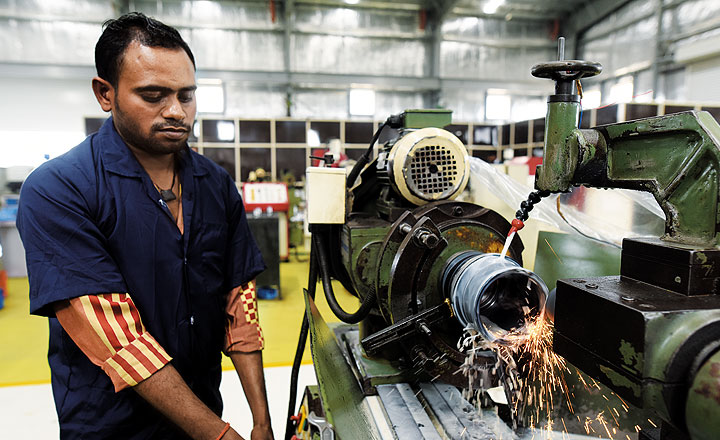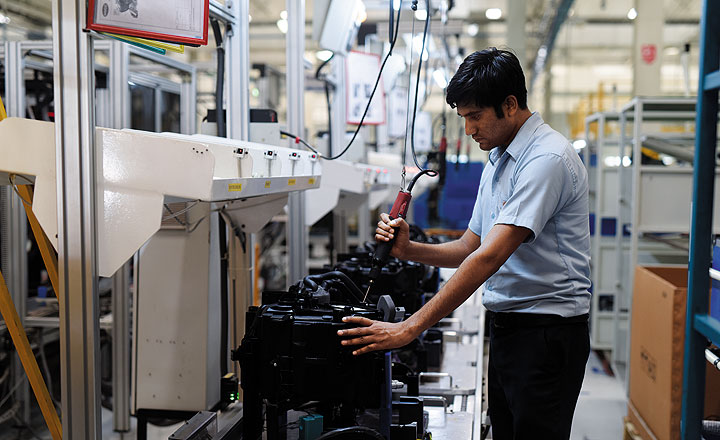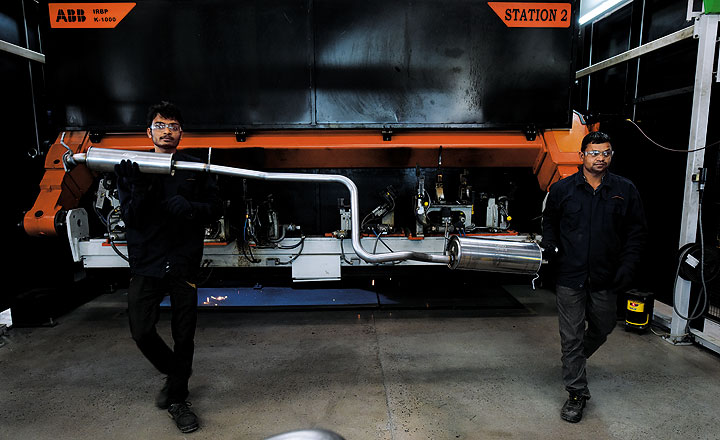It takes us barely 45 minutes to reach the Sanand industrial estate from the Ellis Bridge area of Ahmedabad, hardly surprising considering the quality of Gujarat’s roads. When we eventually reach the 2,000-hectare industrial estate — perhaps the country’s youngest automotive cluster — the whole place seems neatly sectioned, well-marked, sparse, and quite spaced out. For an emerging industrial cluster, at first glance, Sanand seems awfully quiet. Very soon, we find out just why. As per the local industries association’s reckoning, close to 1,000 MSMEs that had been assigned plots at the Sanand estate have been slapped with penalties to the tune of Rs.1,000 crore over alleged non-utilisation of land.
Stop work
“This estate was intended not only for automotive companies and ancillaries but for engineering units, packaging companies, pharma and other allied businesses. While bigger companies such as Tata and Ford can afford to set up their own support infrastructure, MSMEs can’t — the state needs to supply that,” says Ajit N Shah, secretary of the Sanand Industries Association — GIDC Bol. This is where the local industry body, the GIDC, has failed small business owners, he says. “GIDC began plotting, assigning and distributing land as early as 2011, when the Tata Nano plant moved from Singur in West Bengal to its current location here. But while Nano got a red-carpet welcome, smaller units had to wait until March 2015 for basic infrastructure. As per RTI records accessed in 2013, GIDC accepted that construction for amenities like water supply, electricity and roads was still underway.”

GIDC rules say that all units have to commence production within two years of allotment or face penalties. “Many small business owners were allotted land in 2011 but got a water connection only towards end 2014,” explains Shah. As per his estimates, nearly 1,000 small industries were left in the lurch in the process. “Now that the civic infrastructure is in place and units are submitting plans for plants, we are being slapped with penalties. If you own a 5,000 sq m plot, today, you will have to cough up nearly Rs.2,542,000 in penalties. With interest, this adds up to nearly Rs.1 crore.”
Shah says there is no way small business owners can afford to pay such a huge amount even before commencing construction, which is probably the reason behind the eerie silence at the estate. “The affected units are shut because of this order and 15,000 workers are affected in the process.” While the GIDC board had in May 2015 passed an order to waive penalties, it reversed its stand in February, Shah says. “Now, we have no option but to explore legal recourse,” he adds.
“There is no other precondition that these units are not meeting. The longer the GIDC defers a decision, the more interest we will end up paying. But why should we pay for its mistakes?” says Shah. It’s not like the units have much recourse for finance, either: the nearest bank branch is 20 km away. And banks won’t disburse funds till the GIDC gives them a go-ahead. This vicious circle, Shah says, is what is squeezing local units. “We even asked GIDC for a stay on penalties so we could start work. We are willing to submit an undertaking in the event of an adverse decision. But they didn’t agree to even that.” As per his estimates, only 40-50 big units have set up shop in this industrial estate so far. There was no reply from the GIDC VC and MD to a query on the matter at the time of going to press.
Small wonder
Despite the odds, Fairfield & Powerdrive Technology, a ball bearings maker that supplies to Ingersoll Rand and other Fortune 500 companies in the US, is among the companies that are soldiering on. Its Sanand facility was in the works for the past four or five years, but it is only in the past two years or so that the civic infrastructure has been up and running, says president Madukar Murarka. “I have seen more factories coming up here in the past year. But in terms of infrastructure, even today there are no public services.” Absence of regular public transport means the company shuttles its 50 workers from Naroda to the plant and back every day, which is a three-hour drive, one-way. “That is non-productive effort of almost six hours a day,” exclaims Murarka. Besides, he says, GIDC rules prohibit residential construction for workers within the cluster. “We have almost 55,000 sq m of land in all, but they have told us we cannot build housing there. In China, most of the workforce stays near the factory, ” says Murarka.

Getting skilled labour is another problem. “We are currently running a single shift but want to increase that to three shifts, ramping up the workforce to 100 over the next two months and to 500 by 2018. But I see an uphill battle ahead,” says Murarka, adding that plans to hire more women from nearby villages, too, haven’t worked. “There have to be incentives by the government to employ women in the workforce, maybe in the form of subsidies or tax breaks.” Murarka adds that he isn’t the only one who’s trying — and failing — to recruit more capable workers. “As far as I know, Ford India (which set up a plant here in July 2015) brings workers from Mehsana, which is at quite a distance. The government should start engineering colleges or industrial technical institutes to supply a dedicated workforce.” Another suggestion is for the state to give subsidised power for night operations.
While Fairfield currently supplies bearings used in conveyor systems in coal and mining businesses, the company is exploring plans to enter the automotive sector with bearings and flywheels, which is also why it invested in so much land at Sanand. “Our plan is to spend $30 million in the coming years, mostly on buildings and plant machinery. We plan to set up 14-15 units like the 1,500 sq m one we have right now,” says Murarka. Because of the slowdown, companies that used to pay Fairfield in 30 days are now taking up to 90 days. “I think the credit crunch will continue. We are going to see more squeeze from Fortune 500s and working capital requirement will go up.” Despite all these challenges, Murarka is optimistic about FY17. “I think we will grow 50-100%.”
All is not well
Other companies in the cluster haven’t had an easy stay so far, either. Among them is Sanand’s most well-known resident — Tata Motors and its pet project, the Nano. A source who has been working in the cluster almost since inception and did not wish to be identified says that the company had assured production of 195,000 vehicles in the first year but barely managed 65,000, which meant that vendors — who were paying Tata rent, having moved into its vendor park — started feeling the heat. “Most vendors eventually started supplying from their plants elsewhere in the country, since running Sanand operations became unviable,” he says.
From a 24-hour shift, production reportedly shrank to a single, five-day shift of 8-12 hours, the source claims. Then, since raw material requirements were customer-specific but production was down, vendors ended up holding raw material inventory for longer periods. All this added up to vendors going into losses and not hitting breakeven for a long time, he explains. “2012-13 was a really bad year. While things got a little better, the economy has tanked since then,” he adds. At the time of going to press, a representative for Tata Motors hadn’t replied to a detailed questionnaire sent by Outlook Business.
The other big name to make its way into Sanand was Ford India. Although the company declined to participate in this story, its ancillary supplier Hanon Systems was forthcoming. Formerly known as HVCC, Hanon is a global partner to Ford and runs three other plants in India at Bhiwadi, Chennai and Pune. Production at its Sanand plant, its latest, started in 2014. “We make climate products for passenger cars, components — radiators, ACs, etc. Since Ford started its plant only in July 2015, we moved some of the Mahindra business from our Chennai site here,” says plant manager Vibhas Raina. While the ease of doing business at the estate has been good, Hanon says it faced challenges in getting suppliers for construction, electricals, air-conditioning and other basics for the plant. “The automotive sector demands high speed and commitment and Ahmedabad did not have that kind of experience. We had to get a lot more suppliers from outside Gujarat.” Once the plant was up, there was another challenge.
“We are tier 1 suppliers to OEMs. But there is a complete absence of tier 2 suppliers in this cluster. We have to travel 40 km from here for all our small components, jobwork and machining work. When the machines are under breakdown, I can’t afford to wait five hours for a small part.” Hanon began sourcing material from outside the state — nearly 50% of its local material currently comes from Chennai — at a significant cost. “Maybe a specific policy by the government to allocate land or create a tier 2 zone would help,” says Raina. But the Nano vendor debacle has made it harder to convince tier 2 suppliers to set shop here; large plot sizes being another reason. “We can’t give them an assurance on business because we are dependent on Ford, so it is a bit of a vicious circle.”
For Hanon, the other key challenge was finding a skilled manpower. “There are domicile rules in play in terms of hiring, but skill levels are very low locally.” The company had to pay higher wages and hire people from outside the state. “We have not been able to hire our full strength — we need 43 people, we have 23. Although the shop floor count has touched 200 and we are looking for people, we might defer hiring given the current scenario.”
Brighter shores
This is because the domestic LCV business itself has been through a slump. “Volumes haven’t picked up. We were supposed to double production this year, but the market response wasn’t there and it had to be deferred,” reveals Raina. Since the company had committed capital investment, a drop in volumes by 30-35% has put pressure on profitability. “We have already invested much of our capex keeping two shifts in mind. In fact, our capacity is to cater to three shifts. This is why shifts coming down hit us badly.” Sales numbers have been significantly lower than projections, and Raina doesn’t see much scope for a revival in domestic demand. The company has its hopes pinned on the new model that Ford reportedly plans to launch in June this year for the European export market.
Hanon’s also been hit by the SC directive banning 2-litre and above engines in the NCR region. “Since Mahindra’s vehicles are mostly above 2 litre, and since that segment has been our biggest revenue generator, we’ve been affected.” With industry hopes being pegged on GST, which is looking increasingly unlikely, it is hard to predict profitability at present, says Raina.

Idling in top gear
Companies like Grupo Antolin India, a Spanish MNC that that manufactures rooflines, headliners and other car interior parts, and Tenneco Automotive India, which creates exhausts and silencer systems for four-wheelers, are also pinning their hopes on upcoming launches by OEMs. “Production is currently down from initial projections. Hopefully, after June, the situation should improve,” says V Pugazhendhi, plant head, Grupo Antolin India. He explains that the dip in domestic sentiment has dragged demand down 30-35% from projected volumes.
While MNCs such as Colgate and Nestlé have also found their way into the estate of late, local businesses are eagerly awaiting Maruti Suzuki’s 1,000-acre plant at Hansalpur, part of the government’s proposed auto hub network. The plant is eventually supposed to churn out 1.5 million units per annum, and Rs.18,500 crore has been poured in so far. By January next year, the first of Maruti’s locally made cars will roll out of the plant. “From an industry perspective, Maruti coming in will probably revive the market, given that it is a market leader. Hopefully, it will bring along tier 1, 2 and 3 suppliers. With the auto industry in full gear, things should move up and benefit the cluster here,” feels Raina.











